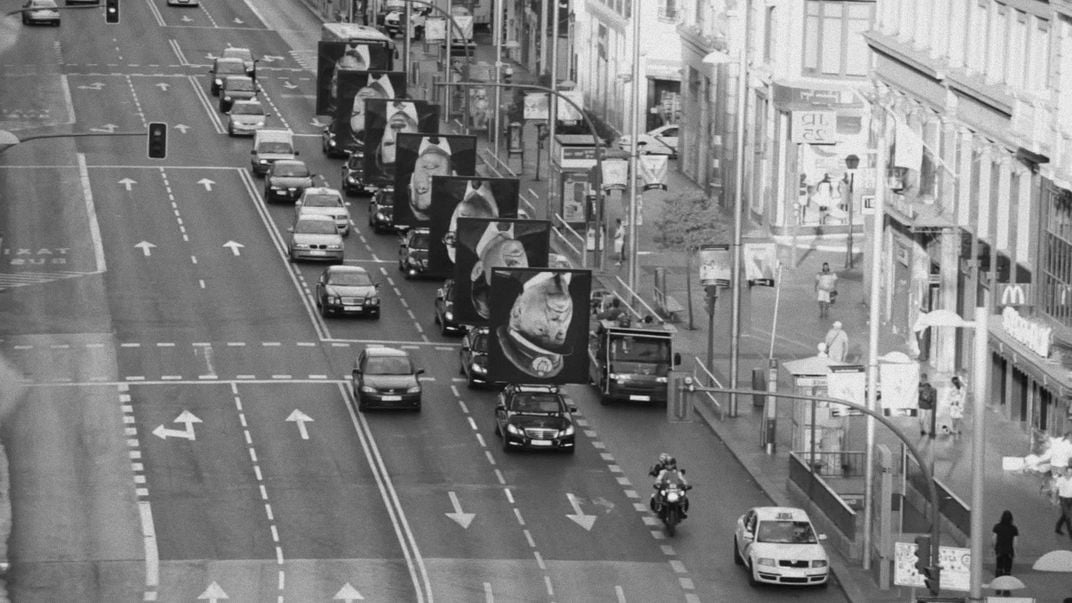Upending Those in Charge
How two artists staged a motorcade in Madrid, touting portraits of upside down politicians to question those in power—in Spain and across the globe.
/https://tf-cmsv2-smithsonianmag-media.s3.amazonaws.com/filer/0c/ed/0cede8e2-3e0a-44d3-9b54-582ae3575807/black_box_santiago_sierra_jorge_galindo_img_02.jpg)
As young artists, Santiago Sierra and Jorge Galindo were drawn to creating pieces that made people a little uncomfortable; they weren’t after art that was static, but instead, work that pushed viewers to ask questions.
But unlike their classmates at the Complutense University of Madrid in the mid-'80s, who seemed to stage shows at nearly any location with ease, the pair struggled to convince most institutions—or at least the city’s more prestigious venues—to accept their provocative pieces. So they took to the streets, staging graffiti and murals across the city. If they couldn’t get permission (which they couldn’t, more often than not) they’d take their chances.
So in many ways, years later, as Spain’s economic crisis began to unravel into political unrest, it wasn’t a question of how the men, who had gone on to build careers in separate cities—Galindo in London and Sierra in Madrid—would return to color the city with their guerilla-style tactics. It was when.
Their 2012 return came unannounced mid-day in August in the form of a live performance piece: An unauthorized parade along the Gran Vía, Madrid's central thoroughfare, of black Mercedes-Benz sedans carrying upended portraits of Juan Carlos I, the sovereign who began Spain’s transition to democracy after the 1975 death of the dictator Francisco Franco, and the country’s six subsequent prime ministers.

Using both original and “found” audio and video, the artists captured the experience in “Los Encargados [Those in Charge]” (2012), a six-minute film now at the Hirshhorn Museum and Sculpture Garden’s Black Box theater. The event, they hoped, would make bystanders “pay heed to the actions of the governing elite”; the film, then, would create a lasting piece that could help others question politicians around the world.
It was “intended as a protest about the political climate in Spain and how, even under democratic rule socio-political and economic problems continue,” curator Kelly Gordon says. But with the film, its reach goes much farther.
Using 12 cameras, the artists captured the procession in black and white as it made its way around the city on unusually empty streets (by chance, there was another demonstration across the city, Gordon says).
The event—which was nearly halted by police, Gordon says—caused a viral sensation after bystanders posted photos and videos online. The beauty of the film—and the editing—is it lets the artists play with perception. In some shots, the portraits, which were created by Galindo, are righted while the cars roll upside down, or backwards, down the streets. In the film, as the procession of cars passed museums, old cinemas and other landmarks, the editors added the populist Polish song “Warszawianka”—the signature anthem of the Spanish Civil War. The screen is split into three as cameras zoom in to the whites of the leaders’ eyes, and an ominous police siren swells and fades as the piece comes to a close.
Some have said the way it was staged calls to mind a motorcade for a funeral, a march toward burial for “those in charge [who] were politically dead”; others say the upended portraits evoke the image of the leaders hanging at the country’s hands.
Gordon, who first saw the piece in Germany, says the film delivers a “strong and memorable statement about questioning political power."
“Such elegant black and white somehow adds to the gravitas of the work and alludes to how it connects the past with the present,” she says.
Eerie as it may be, Gordon "was impressed [with] its suggestion [that] 'those in charge' are global,” Gordon says—which means whatever your nationality, the piece will likely find a way to spark a bit of introspection.
“Los Encargados: (Those in Charge)” is on view at the Hirshhorn Museum and Sculpture Garden through May 18.
UPDATE: A previous version of this story reported that the music was blasting from the cars, but in fact the sound was added during film production. We regret the error.
/https://tf-cmsv2-smithsonianmag-media.s3.amazonaws.com/accounts/headshot/erica-hendry-240.jpg)


/https://tf-cmsv2-smithsonianmag-media.s3.amazonaws.com/accounts/headshot/erica-hendry-240.jpg)